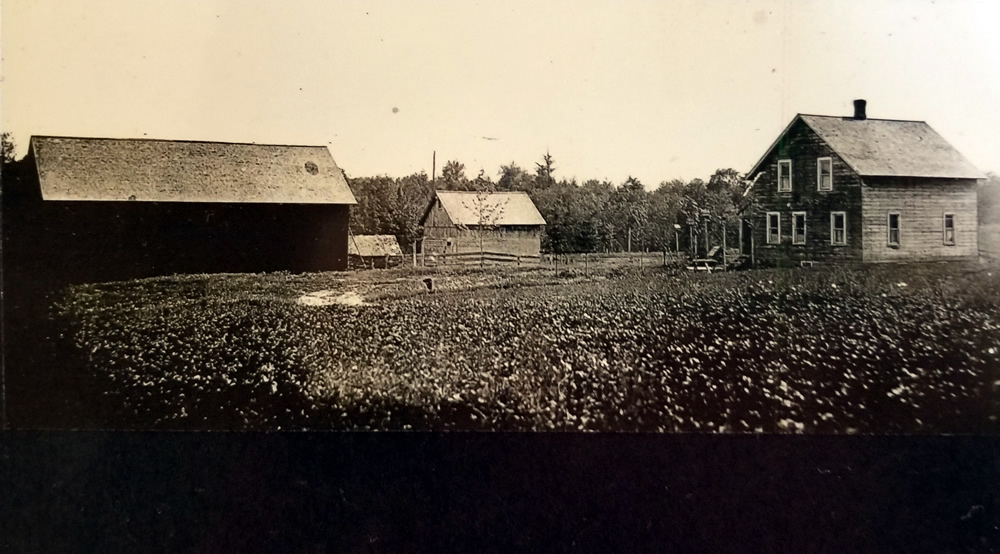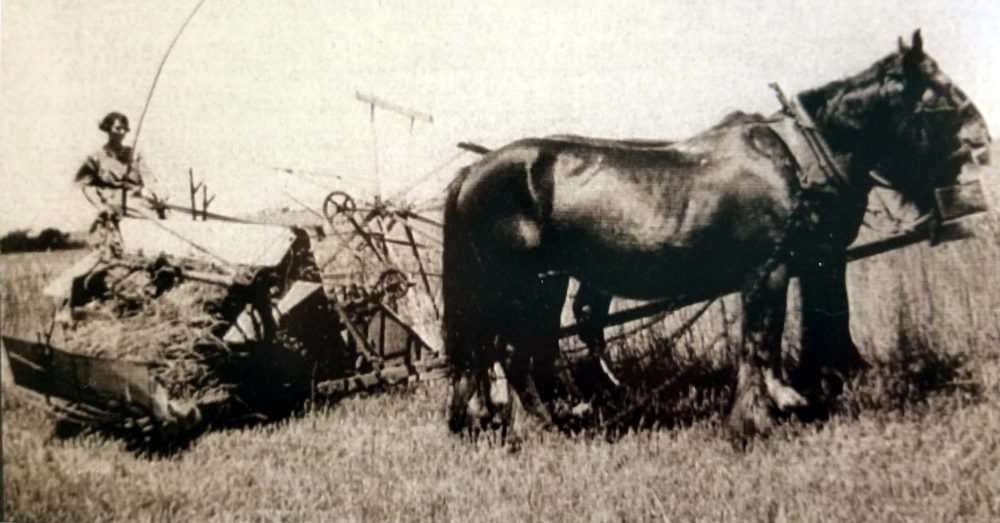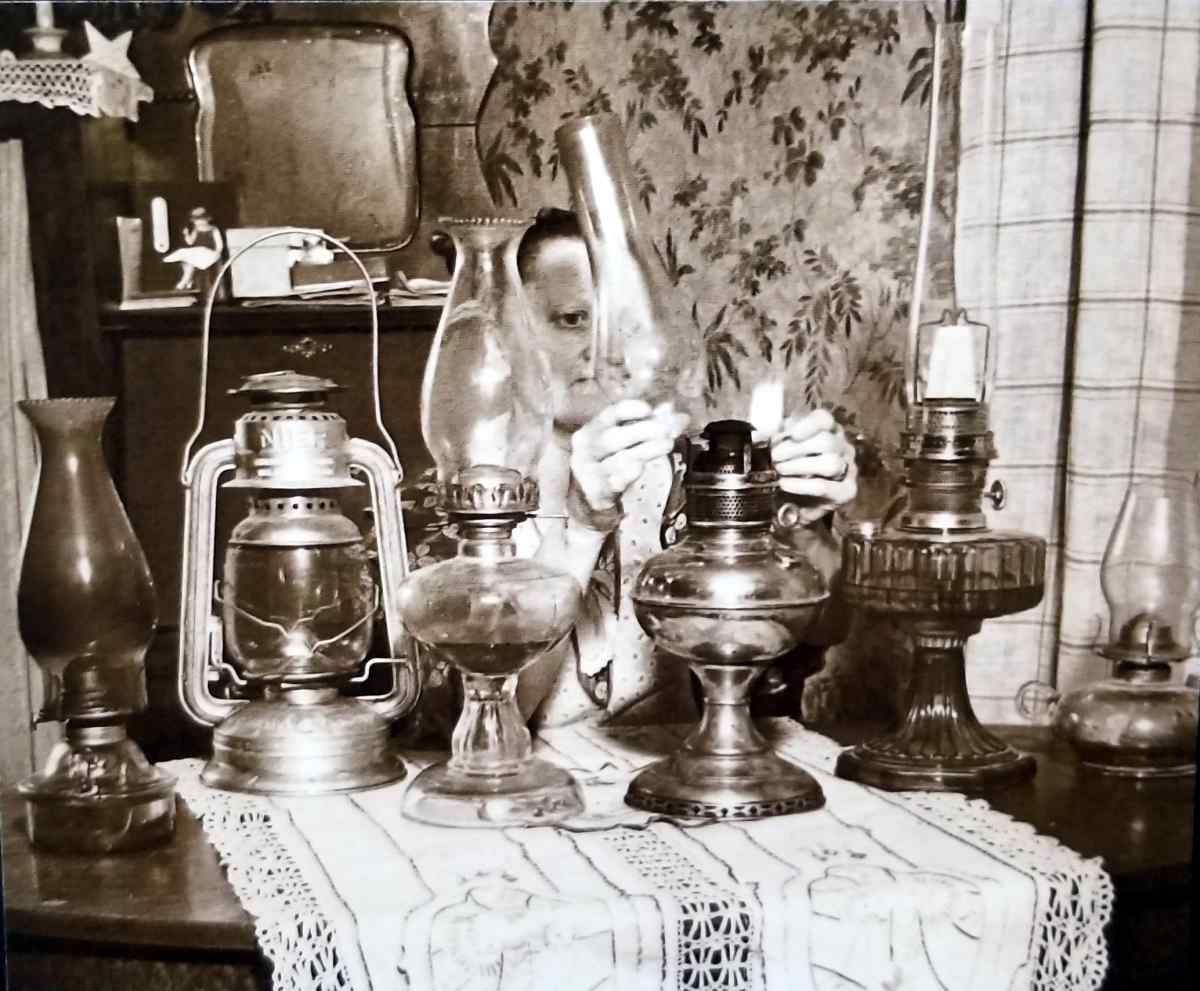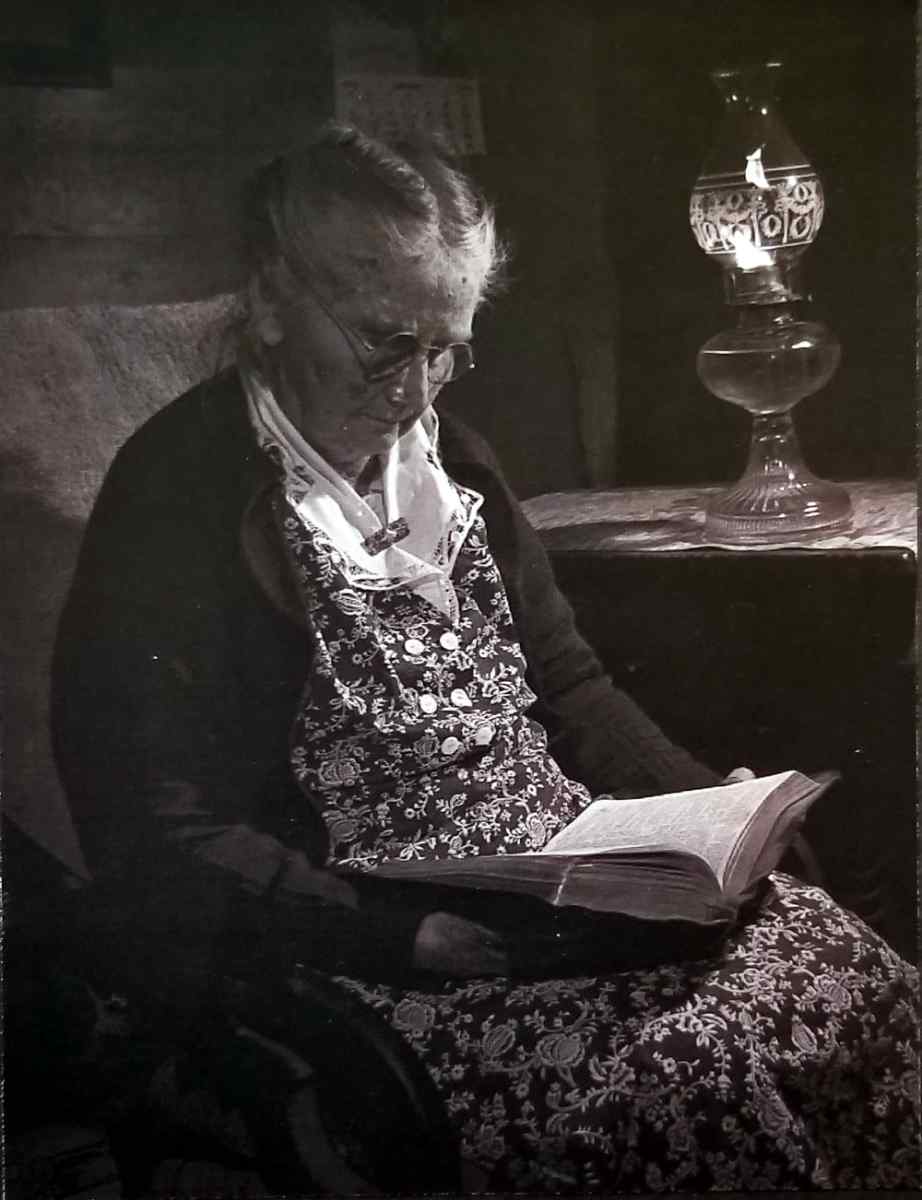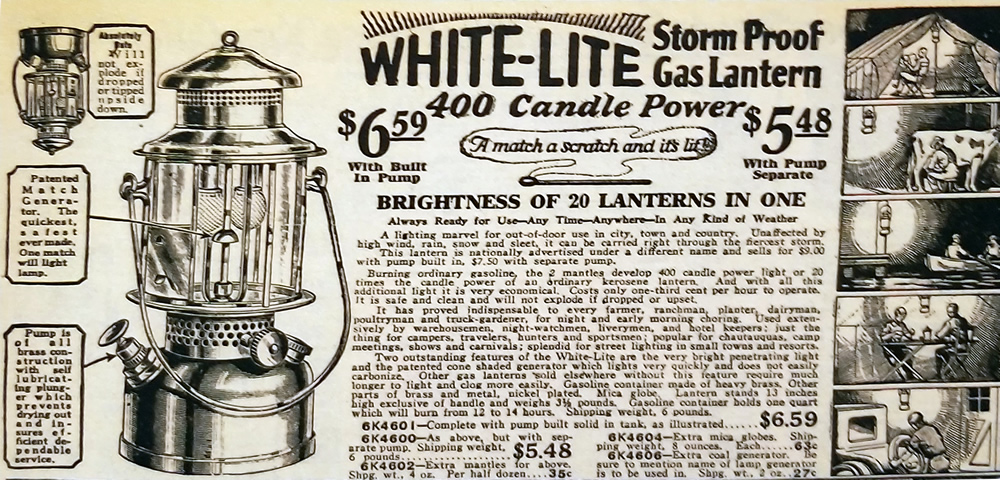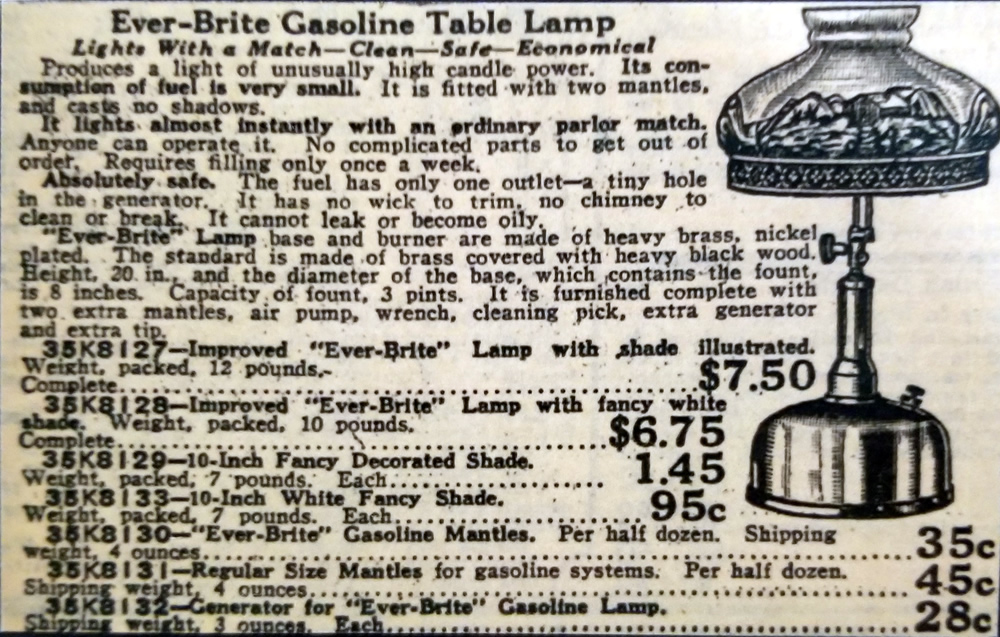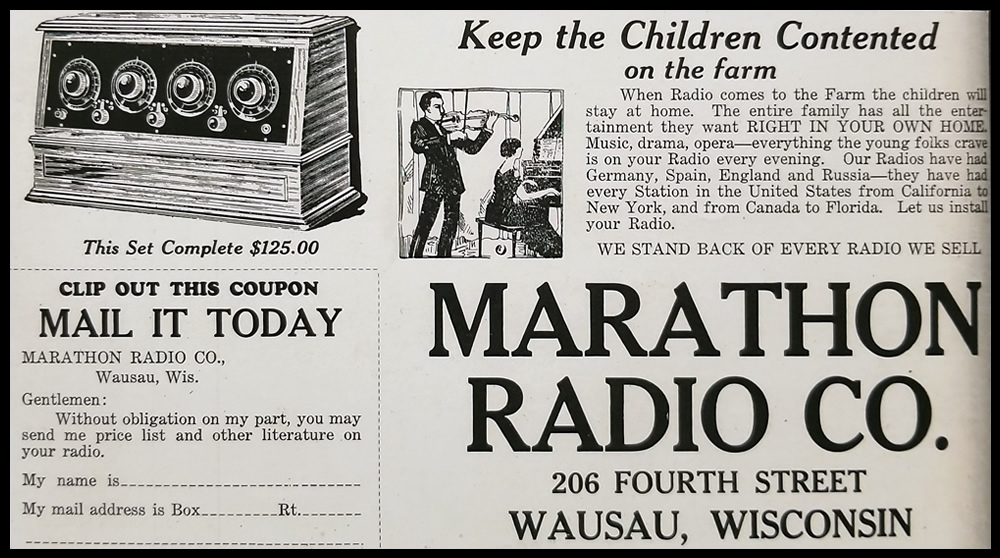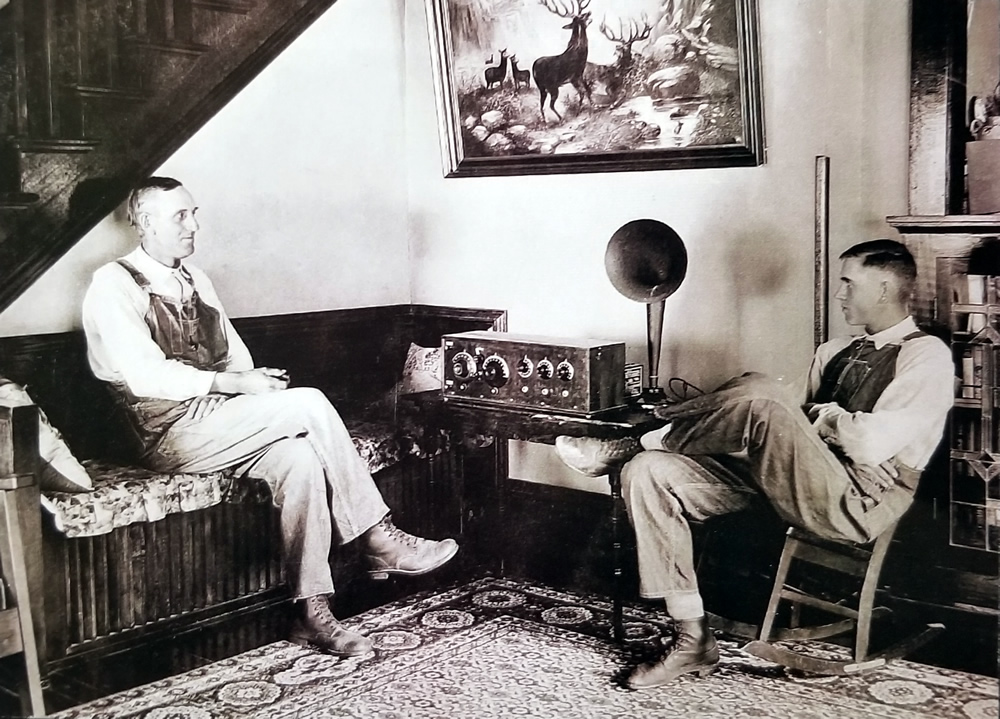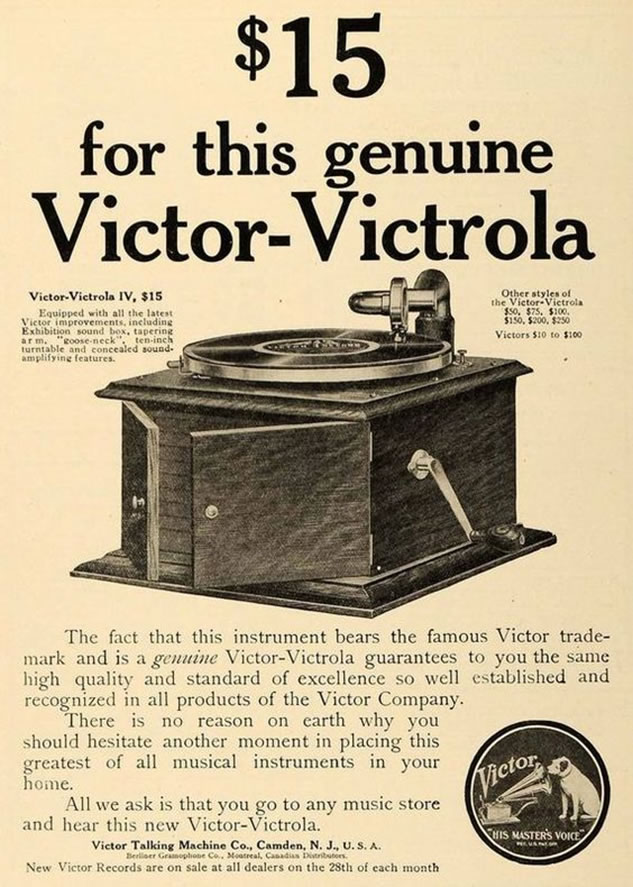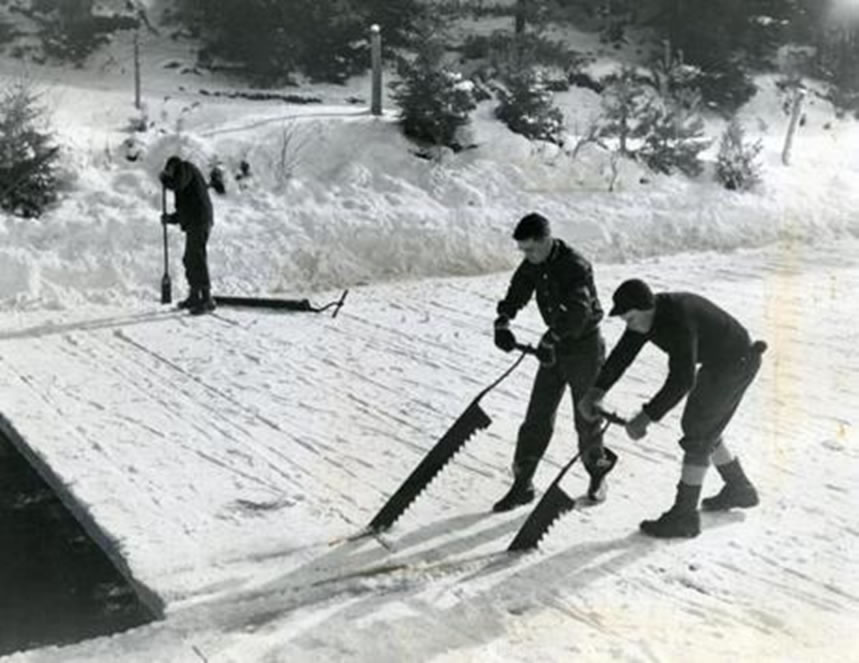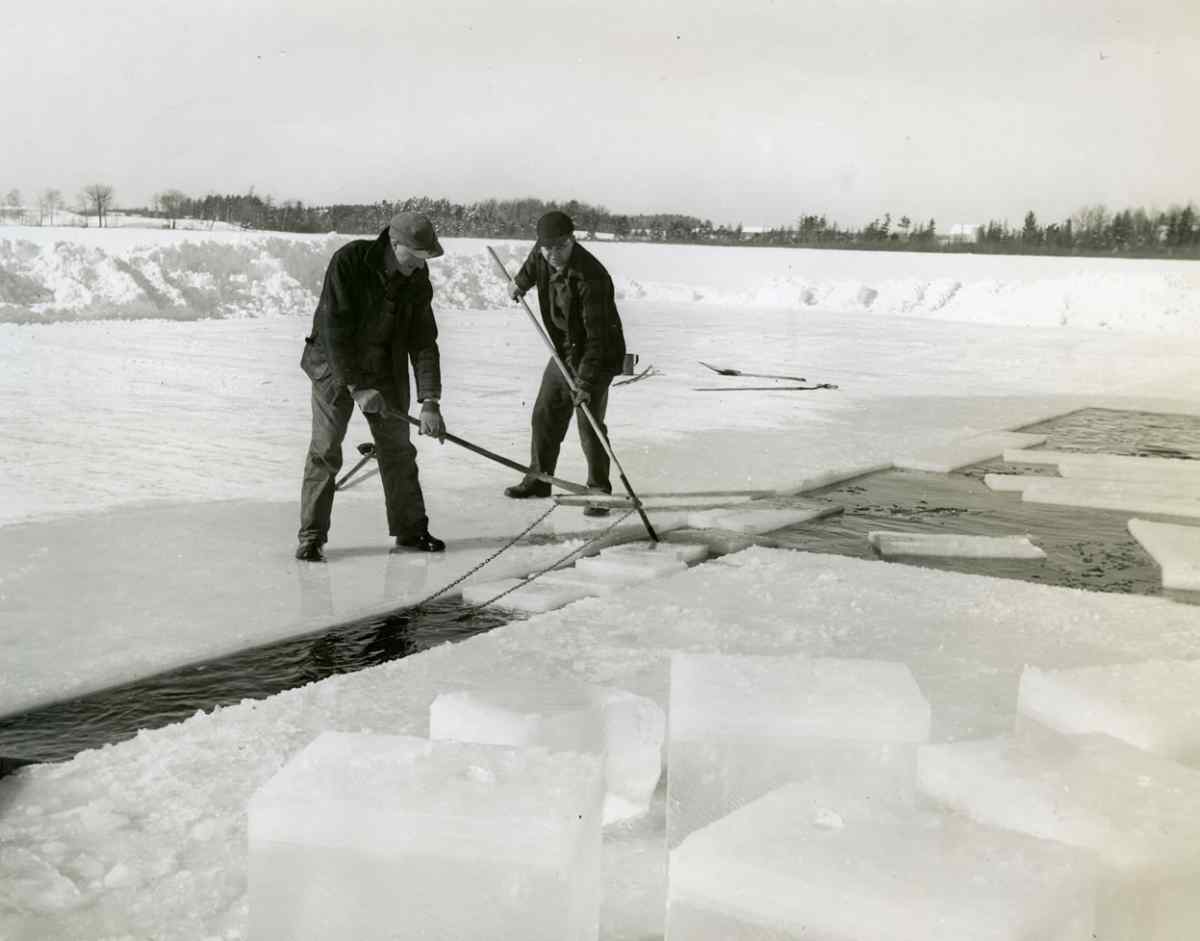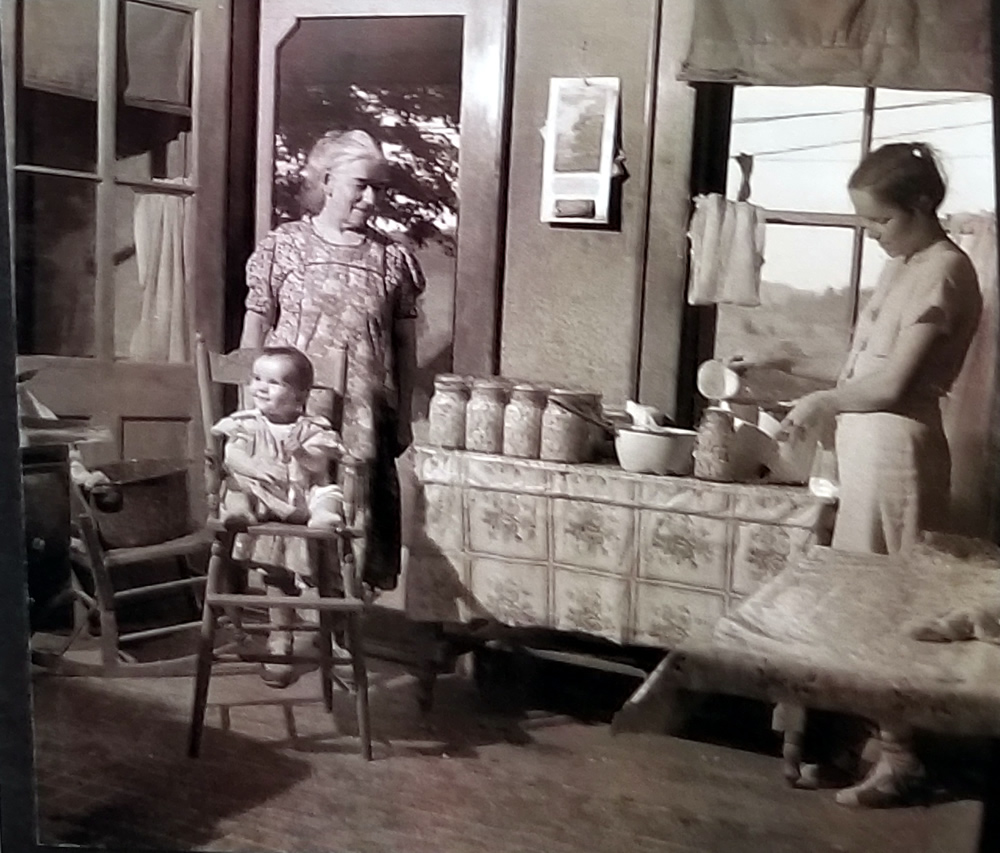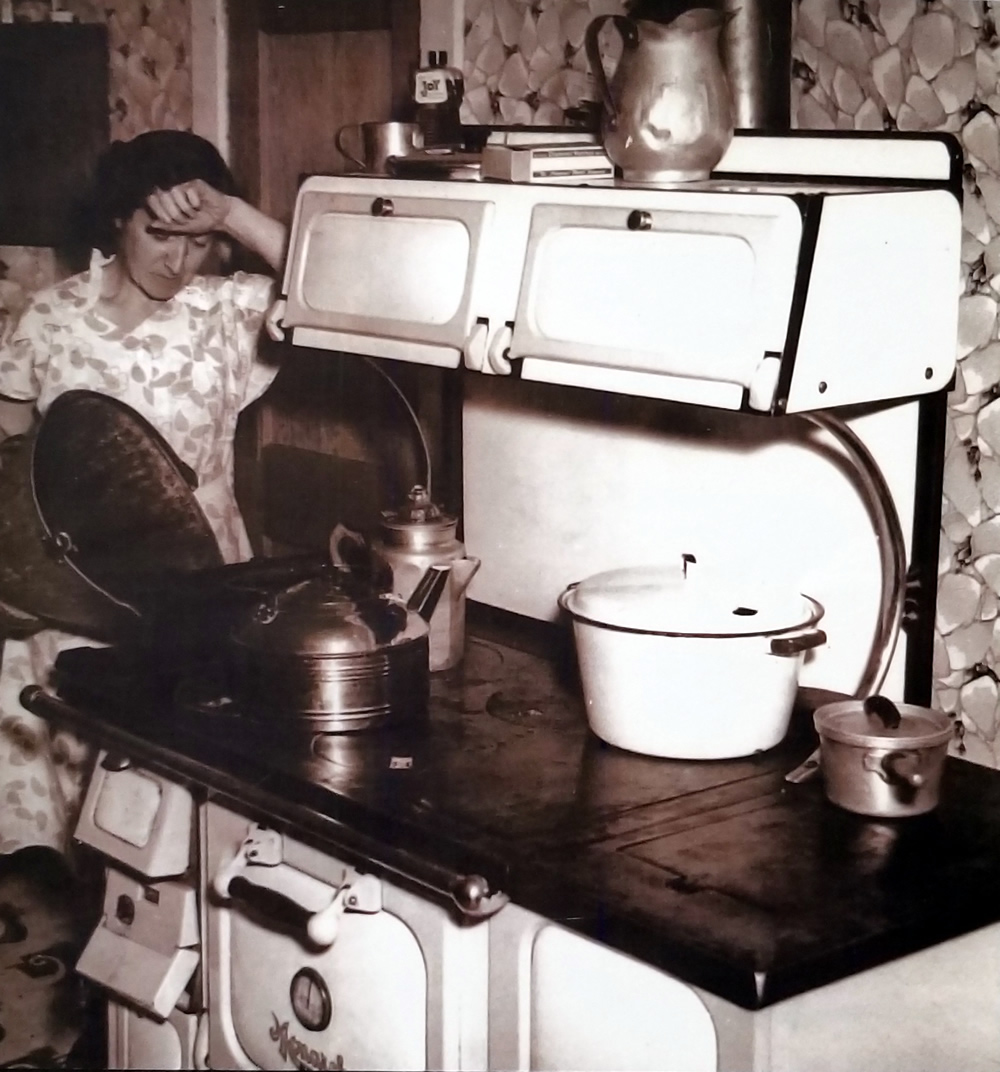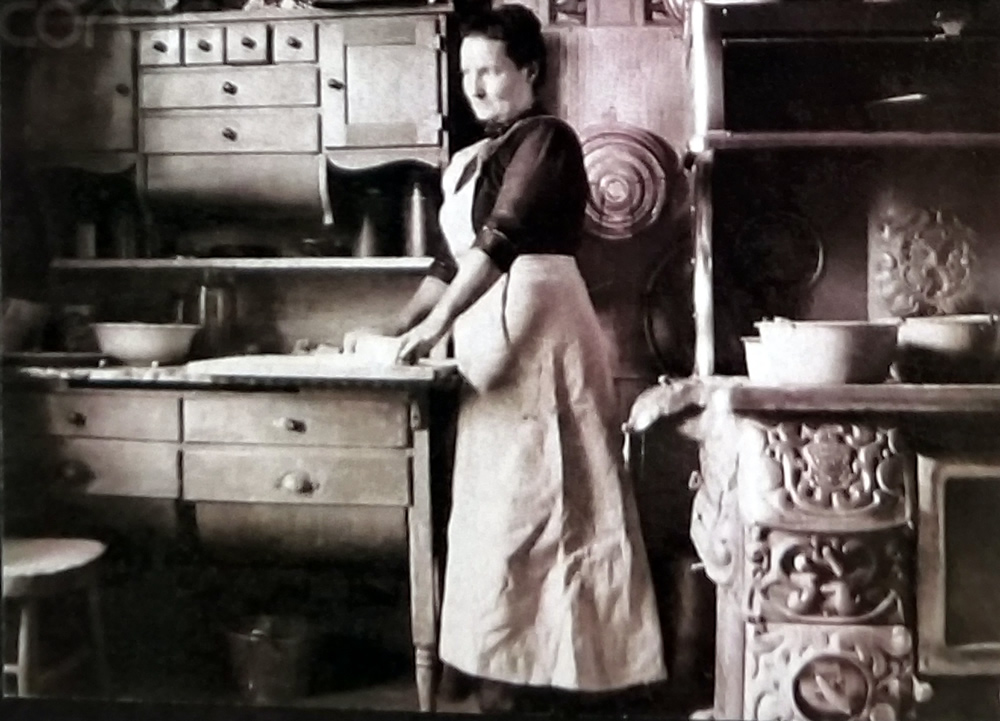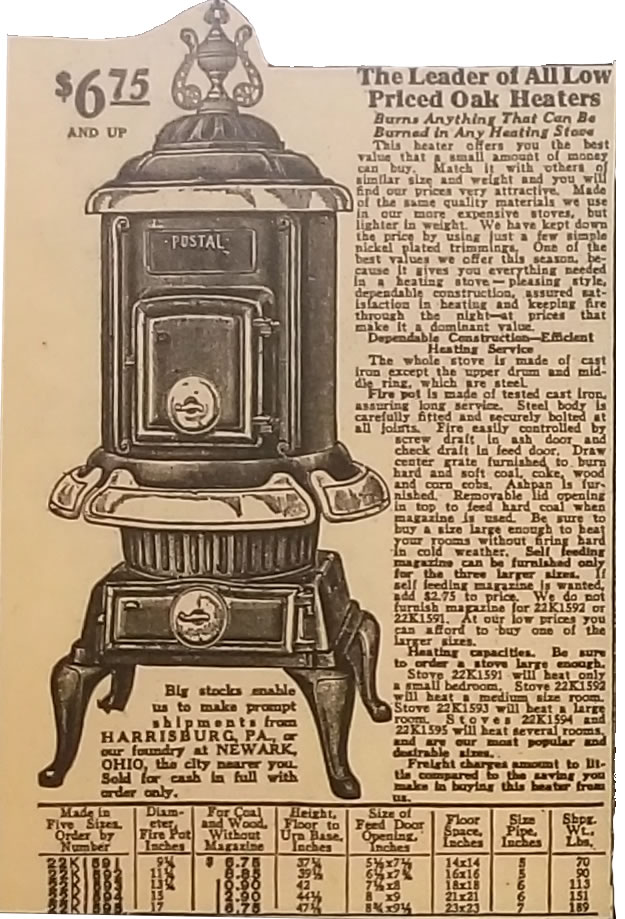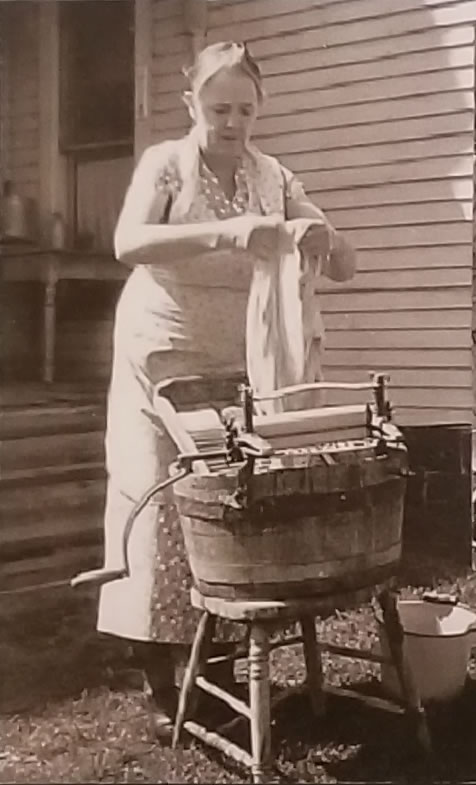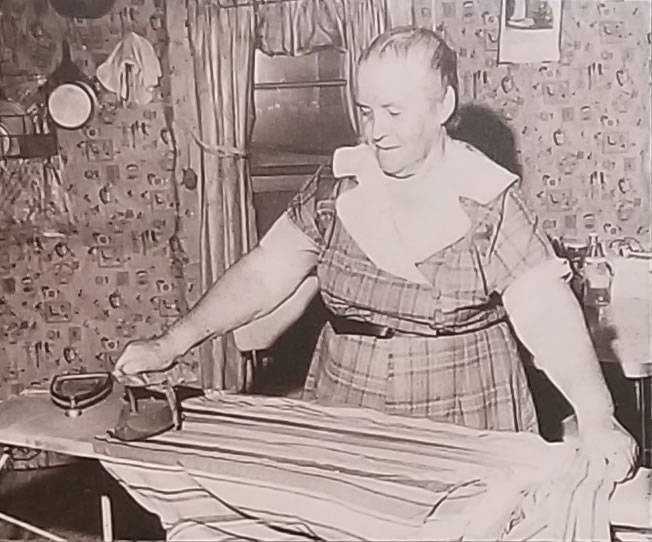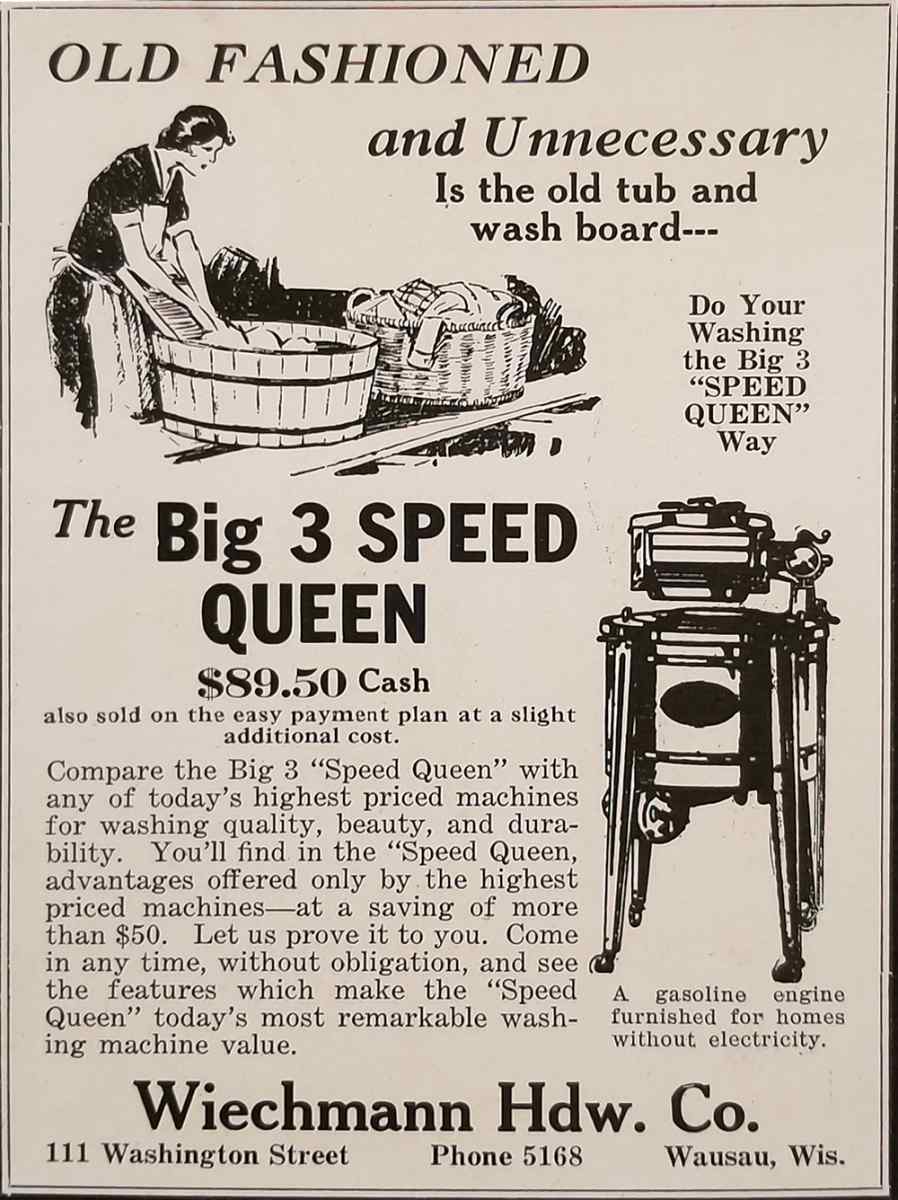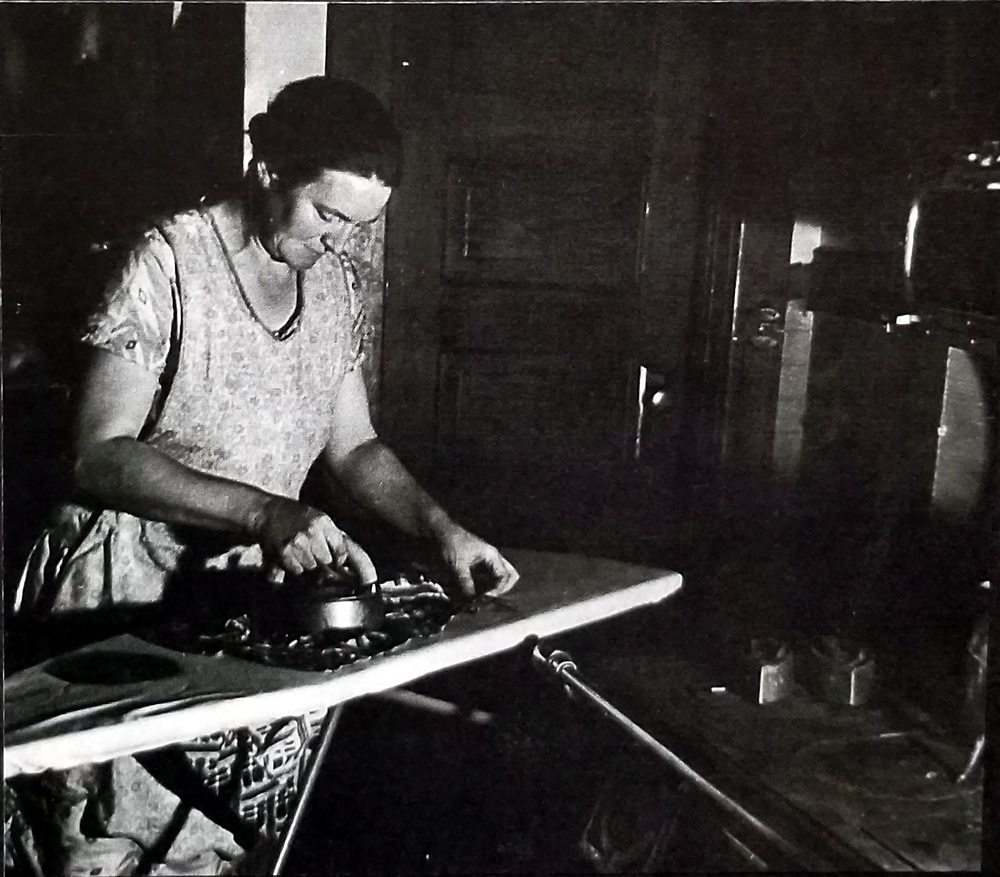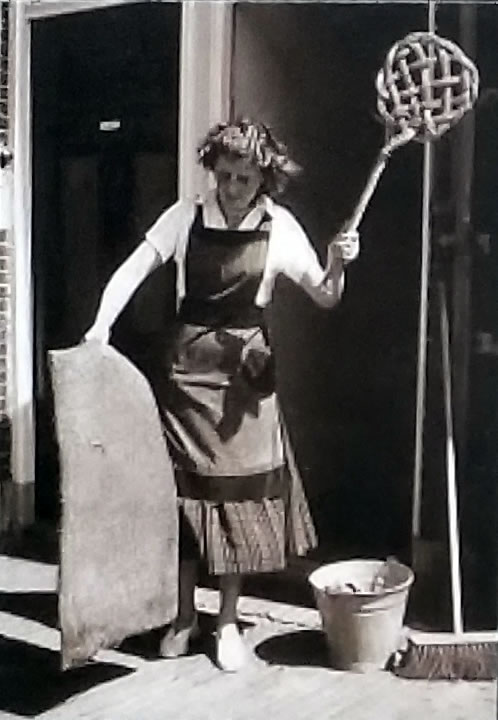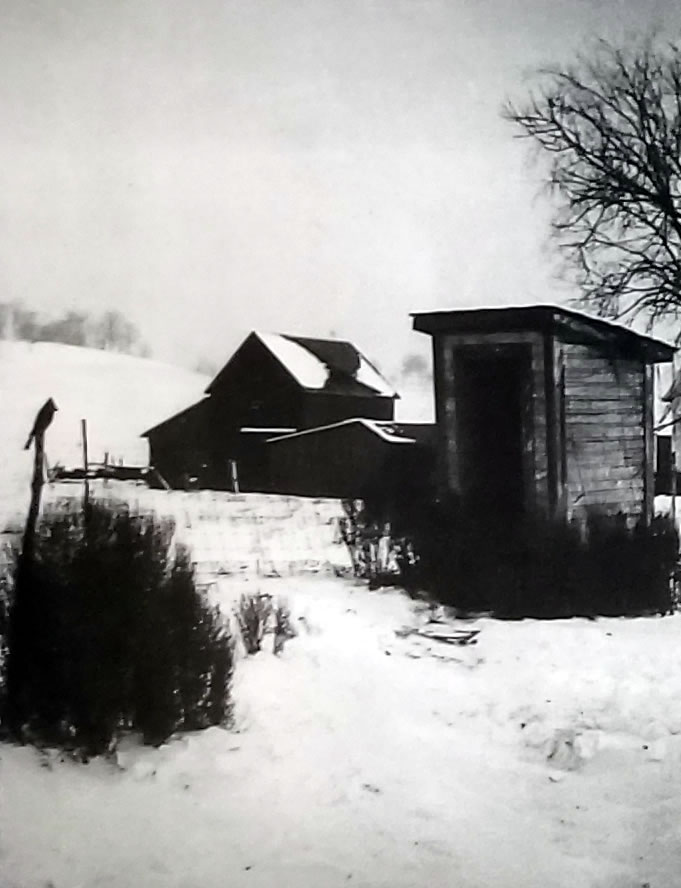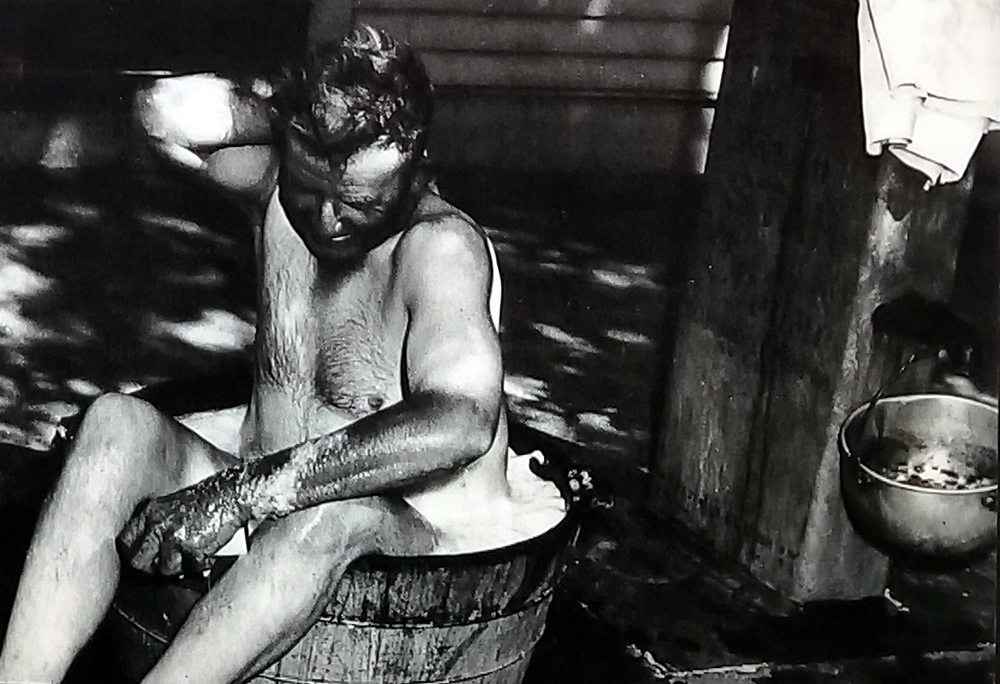Rural Life Before Electricity
Rural Life Before Electricity
Click Images To Enlarge
Living Without Electricity
In the early 1900s, before electricity, power to accomplish everyday tasks came from the labor of the entire farm family and their hired hands, plus horses and windmills. Occasionally stationary gasoline engines were used to run pumps, washing machines or other equipment.
Wood to heat the house and fuel the kitchen stove had to be cut and split by hand. Water was pumped from a well and had to be hauled, bucket by bucket, to the house or barn. Cows were milked by hand. The “toilet” was an outhouse in the yard. The heart of the home was the kitchen table with a kerosene lamp in the center. Here the family ate, read, did schoolwork, mended clothing and entertained neighbors.
We lived on the farm, kind of way out, and so we had no electricity. We had no milking machines, no electric lights and no running water. We had an outhouse. We had kerosene lamps.Ann Hardie, rural Edgar, in the 1920s and 30s
In 1944 there was no electricity, no inside plumbing. Gas lantern and kerosene lantern was the source of light after dark. Bathroom was an outhouse 50 feet away from the house. A wood burning stove heated water. A wood burning furnace heated the house.Lester Schneider, Jr., rural Stratford
We were born on a farm and never had a car or a tractor in those days. Everything was done with horses. All of our harvesting and our plowing and everything. I worked with a hand plow with a team of horses.Ned Revie, Town of Wausau, in the 1910s and 20s
Lighting the Home and Barn
Kerosene lamps and lanterns were the main source of light in the house and the barn. The circle of light cast by a kerosene lamp was small and it only gave the equivalent of 25 watts of light. Outside that small circle of light, the rooms of a farmhouse were dark in the evening. Kerosene lanterns in the barn gave the farmer just enough light to see while milking. Each week the kerosene lamps had to be refilled, their wicks trimmed and the glass chimneys cleaned of the accumulated soot, a very messy job.
Gas lamps and lanterns were also used on some farms. They provided a brighter flame but could explode. Fire was always a hazard with kerosene or gas lamps.
Before we always had kerosene lanterns or lamps and every weekend we’d always have to wash all of them chimneys so they’d be clean for the next week. And then later on we got those gas lanterns, they had mantles on them. Boy we thought we had the world by the whatever.Ruth Hartwig Ollhoff
“In the house we had kerosene lamps. In the barn we had kerosene lamps. You got used to looking in the dark, seeing in the dark. The worst to do was having to get the hay out of the barn at night to feed the cows. You didn’t take any lanterns up there, you went by what you could see or feel. But the hay was thrown down from the mound ahead of time in the daytime, all you had to do was push down through the hole for the cattle to eat.”
Leonard Leffel
“In the kitchen they were all gas lanterns, they had white gas and they pumped air in there. One time my ma lit it and KABOOM, my ma opened the front door and threw it because it exploded. They were bright lights, better than a kerosene lamp.”
Bernice Ritchie
“We had (kerosene) lanterns in the barn and kerosene lamps (in the house). We had one in the kitchen and we had one in the dining area which opened up into the living area. We had a lamp stand in the hallway so we could bring the lamp up and set it so then we could see into our rooms. After a while we got a mantle lamp in our living room which was much brighter than the oil lamp.”
Edith Van Vuren Merriam
“Upstairs, the boys would sleep up there. And I know it was always pretty dark when they were dressing there. There was a lantern (kerosene) and my brothers would turn it off when we went to bed.”
Ralph Zagrzebski
“There was always chimneys to be cleaned, black chimneys to be cleaned and then later on we had gas light. They were a little better with the mantels on them but they too were nothing as compared to electricity.”
Ethel Rankl
Entertainment on the Farm
Farm families had very little time for fun and almost never took vacations. Their chores lasted from sunrise to sunset. But after dark the family could gather around the lamp on the kitchen table or in the parlor to chat, sing, play cards or listen to the phonograph or radio.
Phonograph players were powered by a hand crank. Radios ran on batteries and they were expensive, so listening to the radio was a special event. Early radios had headphones, so only one person could listen at a time. Eventually speakers let the whole family hear their favorite programs.
“We had this old-fashioned Victrola record player. The records were about six-seven inches long and they were round (cylinders) and we had to crank it up. After a while we had the flat records but we still had to crank it up because we didn’t have electricity.”
Ann Hardie
“We did a lot of singing. A lot of evenings if you didn’t know what else to do, we’d sit and play our guitars and sing.”
Delores Goetsch Rusch
“We didn’t have a radio until I went out working and bought one. It was a battery radio. I bought it when I was 15 or 16 (1930). It was rounded, almost like a dome shape with dials and a big bunch of batteries that went with it. One of my favorite radio shows was Fibber McGee and Molly. My dad had his favorite ones he would listen to. It really became a family affair to sit around and listen to the radio.”
Helen Mosser
“I remember my sister she bought the first battery radio and that radio had 3 C batteries, one A battery and one B battery. It was a Silvertone. That was back in 1933 or ’34. We had to do our school work first and if we did we had about 15 minutes or at the most half an hour to listen to the radio. Most of it was “Gangbusters”.
Melvin Klinger
“The radio we had had batteries in it. When the battery would fade out we would sit there with our ears real close to the radio so we could hear that program.”
Marion Matz
Refrigeration and Preserving Food
Farm families purchased very little food, aside from flour and sugar. They produced their own meat, vegetables and fruit, but food had to preserved to last the entire year.
“Refrigerators” in the days before electricity were iceboxes in which blocks of ice kept the food cold. The ice was harvested in winter from frozen lakes and stored for use in spring and summer. Only a small amount of food could be stored in an icebox. A more common way of keeping food cool for a few days was to put the containers on the cellar floor, which was the coldest part of the house.
Canning meat and vegetables was essential to the farm family, ensuring a food supply through the winter months. Meat was also smoked to preserve it and cabbage was fermented in brine and stored in crocks to make sauerkraut. Vegetables were stored in cool root cellars over the winter.
“For meat my folks always raised pigs. They would kill maybe a pig or a cow at the same time. We would make sausage out of it. Since there were no refrigerators at that time, they had smoke houses where they would smoke the sausage, so it would keep. They would smoke the bacon in chunks. We also canned meat. We would cut it up in small pieces, brown it and put in jars, then heat it in a boiler for maybe three or four hours.”
Monica Steckbauer
“We didn’t have refrigerators. My dad always made ice. We would go to the lake and make great big cubes. We would store those big cubes in a corncrib. We would put sawdust over the top of them and in between each cube. Then in the summer time we would take the sawdust off, bring a cube in and put in an ice box. In those iceboxes, they would last maybe a day or two. The ice would keep your milk, butter and other stuff cool to a certain extent so it would last longer.”
Monica Steckbauer
“We used to take everything down and put it on the basement floor, anything that we wanted to keep cold. Boy, that basement floor sure used to hold a lot of food and keep it cold.”
Mae Lensmire Gliniecki
“On the farm where I worked we had an icehouse to store the ice. We would put a layer of ice down, then a layer of sawdust, and then another layer of ice and so on. The ice would last the whole year this way.”
Frank Gering
“I can remember putting ice in the shed outside the barn. It had sawdust in it and we would pack ice in it. And so we had ice for about a month, two or three maybe, during the summer. But that was it. And then we got an icebox and we could pick up ice in Wausau. And that was an event.”
Lois Nass Jorgensen
“In the early days my parents had (an icebox) but I don’t remember it. We just used the basement for cooling or in between the window and the screen you know, put things in there in the winter.”
Delores Goetsch Rusch
Heat for the House and the Cook Stove
Wood was the primary source of heat to keep the house warm and to cook the family’s food. The trees in the farm woodlot were important – they provided the wood. It had to be cut down, chopped, split and then hauled into the house.
Wood cook stoves were a lot of work. They needed the constant attention of the cook to keep the temperature even. They made the kitchen unbearably hot in summer, the smoke from the burning wood blackened the walls of the house and the ash box had to be emptied regularly. Some farm wives had kerosene stoves. They had controls to regulate the heat and made for a cooler kitchen.
Stoves for heating also used wood. The second floor of the farm house generally had no heat except for what came up through floor grates from the first floor.
“My mother cooked on the big wood stove. There was cutting wood and splitting wood. We did a lot of that to keep the house and everything going for the winter. The house was heated by wood. In the mornings, we would rush downstairs because my mother had the wood stove going plus her cook stove. We were freezing upstairs so we had to run downstairs to stay warm.”
Ralph Zagrzebski
“We had a (wood) heater in the dining room and then the cook stove was in the kitchen. To heat the upstairs you had registers in the floor. Heat rises and it goes upstairs to heat the rooms. Where my brother and I slept, that was above the dining room. You had a lot of covers, quilts.”
Leonard Leffel
“I remember it would be so cold upstairs and we’d heat rocks in the oven and put them in a nice heavy towel and put it in our beds so our feet were at least warm when we would go to bed.”
Edith Van Vuren Merriam
“Those days I still had a wood cook stove. It was hard to make maple sugar and even for canning syrup because when it starts boiling it goes up so fast. You gotta know your heat. I knew how to bake bread and stuff. You have to know just how hot your oven is to bake. It did have a thermometer on the front of the oven door. But sometimes if you put too much wood in it the thermometer would be going up. A neighbor had a (kerosene) gas stove and for some reason they didn’t want it. She called and said “I got a gas stove here, $25 would you like to have it?" I jumped at the chance.”
Marion Heller Spindler
“We had the old irons that you put on the stove. They would go in the oven at night during the middle of winter because the upstairs walls would be covered with frost so the beds were cold. We would heat those up and wrap them in a newspaper or towel and put them in bed – for feet warmers.”
Brian Bushnell
“In the kitchen I can remember a wood stove with a tank on the side which heated the water. So I think that was the biggest adjustment for my mother to work from, to go from a gas stove in Sheboygan to a wood stove in the country.”
Lester Schneider, Jr.
Washing and Ironing Clothes
Washday was a huge chore for the farm wife. Buckets of water were hauled from the pump in the yard to fill a big copper tub, which was heated on the cook stove. The clothes were scrubbed on a washboard in a tub or put in a washing machine. The hand-crank on a washing machine moved a paddle back and forth to agitate the clothes. The clothes were put through the hand-cranked wringer to remove the water, then rinsed and put through the wringer again. Clothes were dried on the clothesline outside – an easy task in sunny dry weather but in winter the clothes froze and had to be thawed in the house. Some lucky housewives had a gasoline motor to do the agitating, but the rest still had to be done by hand.
Ironing was another major chore. Irons were heated on top of the stove and would stay hot for only a few minutes, so there were always several irons heating while one was being used. Soot from the stove could stick to the iron and stain the clothing, making it necessary to wash the item again.
“(In the winter) I’d hang the clothes outside and if the weather looked fairly still I’d leave them outside and then they’d dry. They’d freeze dry. They were frozen already and I said to Arnie, ‘Do you think the wind is gonna get strong tonight?’ ‘Oh it doesn’t look like it.’ Then about 2 o’clock I was getting up, dressing and going out and getting the underwear off the line because I was afraid they’d break with the wind being so strong.”
Marion Heller Spindler
“We didn’t have hot running water, so the water would always be brought in from outside and put into a boiler (on the stove). When we’d get it hot enough we’d pour it into those tubs. Then we would scrub the clothes on the scrubbing board to get them clean. To dry them out we’d put then through this wringer. Then you had two rinse waters, so you had to wring the clothes twice. Then you hung the clothes on clotheslines that were outside.
For ironing we had to build a very, very hot fire in the stoves because there was no electricity. We had irons and handles to iron the clothes with. My brothers had a store so they always had white shirts that were very, very difficult to iron.”
Monica Steckbauer
“Everything you wore, except your underwear was ironed. An iron that you heated on the stove. That took something to learn how to iron a white shirt with a starched collar with an iron that you heat on the stove because it was either too hot or not hot enough and the starch would stick on the iron.”
Delores Goetsch Rusch
“We had the wash machine and the scrubbing board out under the apple tree because us kids had to turn the ringer. I remember when my brother was born then Dad got her a gasoline washing machine that you had to step on to get it started. It was in the house. It had a cemented basement and the washing machine could be there. Of course they had to run the water (to it). I remember this washing machine because it had a motor and they had to (vent) the fumes outside. I remember my mom would get so angry at that thing because it wouldn’t start. Finally she’d run to the barn and get my dad to get it going. Once you got it going it was fine. We had to bring all the water in (in buckets) and then we had to heat it on the wood stove. We would carry the hot water down into the basement.
Ironing with sad irons: We had like 3 sizes, a larger one that weighed a pound at least. Then there was one that was easier to go around the collars and sleeves. But they were pretty heavy and we had one handle. You would release the handle and you would get another hot one. (It would stay hot) at least ten minutes at the most.”
Edith Van Vuren Merriam
“Before electricity all the clothes were hanging outside. In the wintertime, I know she would take the clothes and put them in the attic. So they dried in the attic but I can remember at times it would get real cold and it would be warm with the heat going up, well sometimes you would go up and grab the clothes and they were frozen because they didn’t get a chance to dry yet. But in the summer, of course, they were outside.”
Ralph Zagrzebski
Human-Powered Appliances
Chores on the farm and in the home required a lot of hard, manual labor. Milking the cows was done by hand (which could take two hours for 20 cows, twice a day). The farmer could use horses or steam and gasoline tractors for some operations on the farm. Occasionally gasoline motors were used to power washing machines and pumps.
Almost everything in the house was powered by the farm family. Cleaning the house was done by hand – broom, rug beater and scrub brush. And a farm house needed a lot of cleaning due to the soot from the wood stoves and the dirt tracked in from the barnyard.
The kitchen “mixer” was the farm wife using an egg beater or spoon. The treadle sewing machine had a foot pedal.
“In the spring, we’d take the living room rug out and beat it. We had a rug beater and just pounded the living daylights out of it and get out all the dust. Mother didn’t have a vacuum cleaner so what we would do is wet newspapers once a week, put it on the rug and then sweep it. That kept the dust down.”
Ethel Reinhart
Water and Sanitation
Water for cooking, washing, bathing and cleaning came from the well via a pump in the yard. A windmill or stationary gasoline engine could be used to pump the water from the well, but if neither of those was available the water was pumped by hand.
Sometimes a hand pump was also available in the kitchen, which used water from a holding tank. The kitchen sink was generally a “dry sink”, filled by a bucket or the hand pump. Below the sink water ran out the drain into a bucket, which was then emptied outside. If hot water was needed it had to be heated on the stove.
There was no “bathroom” with sink, toilet and bathtub. Indoor running water requires an electric pump, which was not available. The toilet facilities were the outhouse in the yard or the covered porcelain chamber pot in the bedroom. The sink was a basin and the bathtub was a large tub in the kitchen used in succession by the whole family on “bath night”.
“There were outdoor bathrooms. You would take a lantern when you would be going outside at night when it was 20 below zero.”
Marion Matz
“Saturday night baths were always the biggy. The girls got to get in the tub first in the kitchen on the floor. By the time the boys (got their turn) the water was getting a little cruddy. But everybody took a bath in that same tub of water. That was always our Saturday night bath until we had indoor plumbing.”
Mae Lensmire Gliniecki
“We had to carry our water and the pump was quite a ways from the house. So you didn’t waste a drop of water because you had to carry it.”
Delores Goetsch Rusch
“We just had a pail with a dipper in it to drink water. No faucets or anything – they came later too.”
Edith Van Vuren Merriam
“There was a hand pump from a cistern in the kitchen. That was just the water we used to wash our hands and heat it for washing. The drinking water we carried from a pump house (in the yard) in a pail.”
Mary Hamann Schultz
“I had to carry water from the start. Then when my third baby was born (in the 1930s) I got cold water piped into the house and I didn’t have to carry water any more. Then we put a drain in so the water would drain out but I still had to heat the water.”
Florence David

